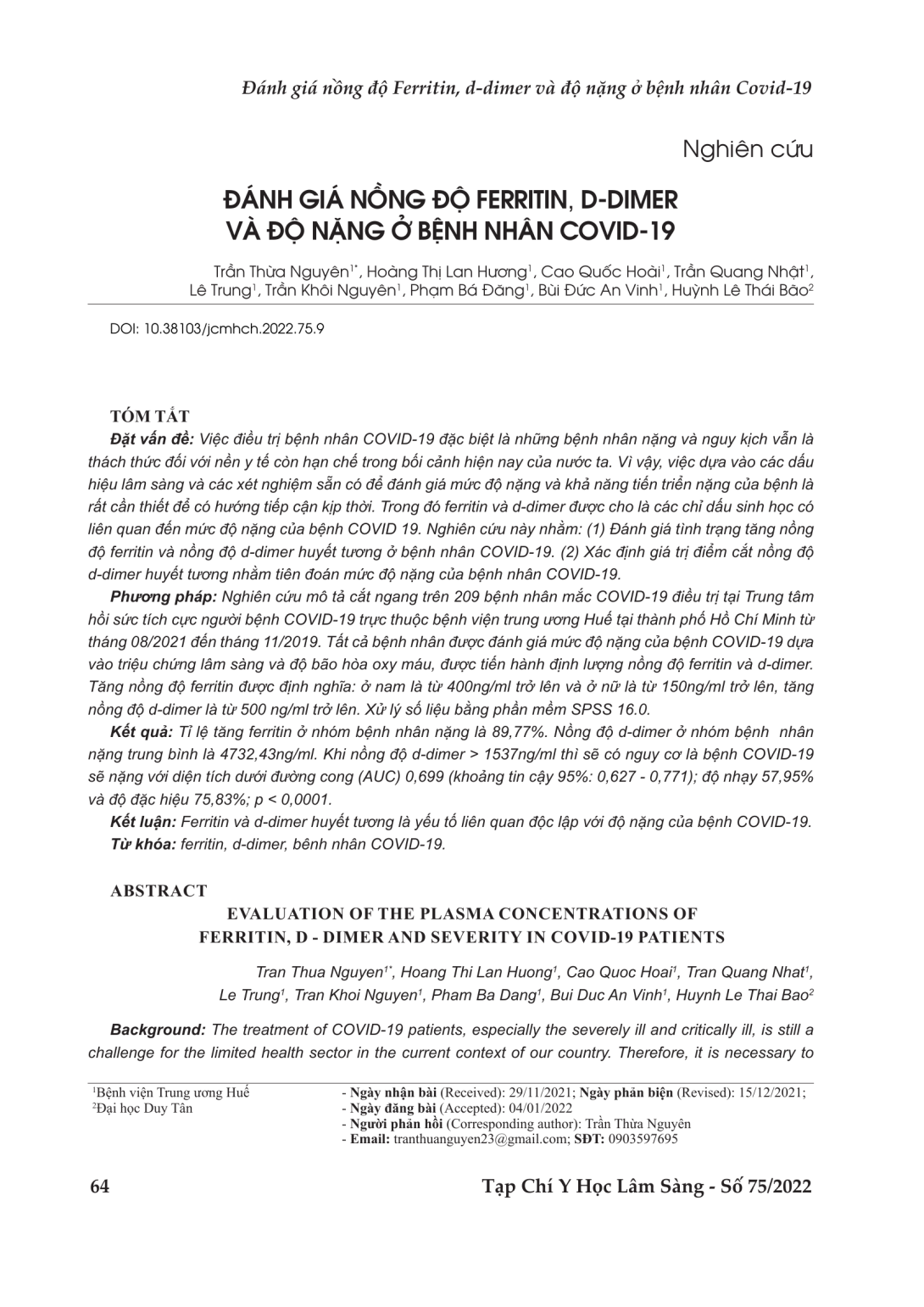
Việc điều trị bệnh nhân COVID-19 đặc biệt là những bệnh nhân nặng và nguy kịch vẫn là thách thức đối với nền y tế còn hạn chế trong bối cảnh hiện nay của nước ta. Vì vậy, việc dựa vào các dấu hiệu lâm sàng và các xét nghiệm sẵn có để đánh giá mức độ nặng và khả năng tiến triển nặng của bệnh là rất cần thiết để có hướng tiếp cận kịp thời. Trong đó ferritin và d-dimer được cho là các chỉ dấu sinh học có liên quan đến mức độ nặng của bệnh COVID 19. Nghiên cứu này nhằm: (1) Đánh giá tình trạng tăng nồng độ ferritin và nồng độ d-dimer huyết tương ở bệnh nhân COVID-19. (2) Xác định giá trị điểm cắt nồng độ d-dimer huyết tương nhằm tiên đoán mức độ nặng của bệnh nhân COVID-19. Phương pháp: Nghiên cứu mô tả cắt ngang trên 209 bệnh nhân mắc COVID-19 điều trị tại Trung tâm hồi sức tích cực người bệnh COVID-19 trực thuộc bệnh viện trung ương Huế tại thành phố Hồ Chí Minh từ tháng 08/2021 đến tháng 11/2019. Tất cả bệnh nhân được đánh giá mức độ nặng của bệnh COVID-19 dựa vào triệu chứng lâm sàng và độ bão hòa oxy máu, được tiến hành định lượng nồng độ ferritin và d-dimer. Tăng nồng độ ferritin được định nghĩa: ở nam là từ 400ng/ml trở lên và ở nữ là từ 150ng/ml trở lên, tăng nồng độ d-dimer là từ 500 ng/ml trở lên. Xử lý số liệu bằng phần mềm SPSS 16.0. Kết quả: Tỉ lệ tăng ferritin ở nhóm bệnh nhân nặng là 89,77%. Nồng độ d-dimer ở nhóm bệnh nhân nặng trung bình là 4732,43ng/ml. Khi nồng độ d-dimer > 1537ng/ml thì sẽ có nguy cơ là bệnh COVID-19 sẽ nặng với diện tích dưới đường cong (AUC) 0,699 (khoảng tin cậy 95%: 0,627 - 0,771); độ nhạy 57,95% và độ đặc hiệu 75,83%; p < 0,0001.
The treatment of COVID-19 patients, especially the severely ill and critically ill, is still a challenge for the limited health sector in the current context of our country. Therefore, it is necessary to rely on clinical signs and available tests to assess the severity and possibility of severe progression of the disease to have a timely approach. Among them, ferritin and d-dimer are thought to be biomarkers related to the severity of COVID-19 disease. Therefore, this study aims to evaluate the increase in plasma ferritin concentration and the plasma concentrations of d-dimer in COVID-19 patients and to determine the cut-off of d-dimer to prognosis the severity in COVID-19 patients. Methods: A cross - sectional study was performed on 209 COVID-19 patients at COVID-19 Intensive Care Center ofHue Central Hospital in Ho Chi Minh city from August 2021 to November 2021. All patients were evaluated the severity of disease based on symptoms, signs, and saturation of oxygen in the blood and were measured plasma concentration of ferritin and d-dimer. The increase ferritin concentration is defined as higher than 400ng/ml in men and 150ng/ml in women; d-dimer was elevated when ≥ 500ng/ml. Data were analyzed by SPSS version 16.0. Results: In the severe patient group, the increase ferritin concentration accounted for 89.77%, the average concentration of d-dimer was 4732.43ng/ml. When the d-dimer concentration was more than 1537ng/ml, there was a risk that COVID-19 would be severe with the area under the curve (AUC) 0.699 (95% CI: 0.627 - 0.771); sensitivity 57.95% and specificity 75.83%; p < 0.0001. Conclusion: Plasma ferritin and d-dimer concentrations are independent risk factors for severity in COVID-19 patients.
- Đăng nhập để gửi ý kiến
